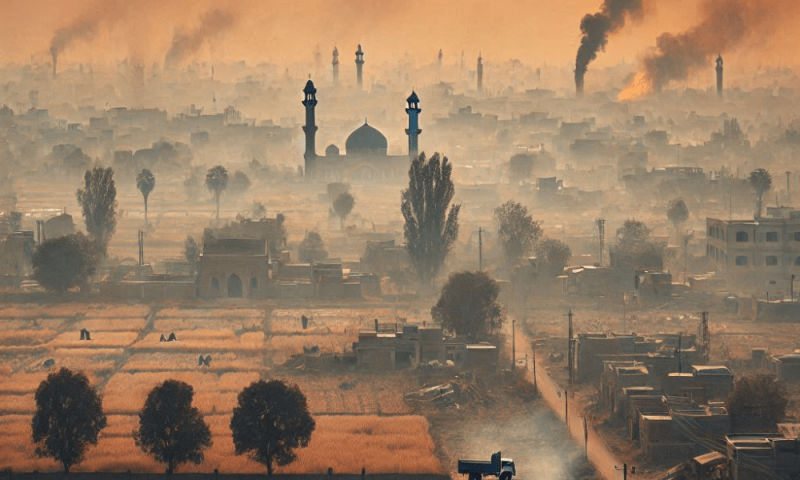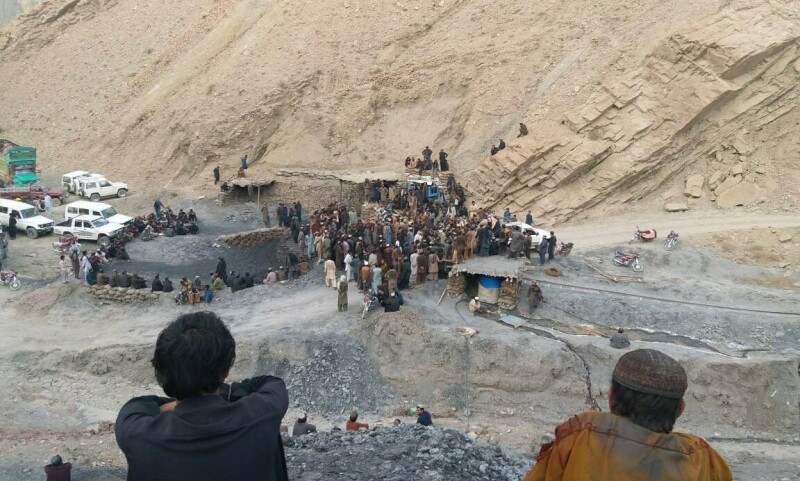From stubble burning to toxic smog, Pakistan’s air pollution crisis threatens its future; the only way it can rise above the haze is through strategic action, with bold policy changes and climate diplomacy at the forefront.
This year, Pakistan’s battle with air pollution has reached harrowing new heights. A shroud of smog — so dense it was captured from space — engulfed vast swathes of the country, catapulting the crisis into the global spotlight and turning it into a significant public health emergency.
The Air Quality Life Index (AQLI) 2024 report reveals that nearly the entire population of Pakistan breathes toxic air laden with fine particulate matter (PM2.5) and harmful pollutants like nitrous oxide, carbon monoxide, ozone, and sulphur dioxide. With a population of 248 million, Pakistan is the second most polluted country, experiencing PM2.5 levels exceeding the World Health Organisation (WHO) standard of five µg/m³ by over 14 times. The State of Global Air report 2024 notes a more than 10 per cent increase in ambient ozone exposure over the past decade, with levels peaking in 2020.
Punjab province, home to 127 million people, saw air quality index (AQI) levels in Lahore exceeded 1,000 — 71.1 times above WHO standards. Multan was even worse, recording PM2.5 levels — 110 times higher than safe limits. The United Nations reported that 1.8 million people need medical treatment, and 11 million children face health risks from the smog. Hospitals in Punjab are overwhelmed with patients suffering from respiratory issues, asthma, and heart ailments.
Poor air quality shortens average life expectancy by three years and three months, climbing to as much as five years in heavily polluted regions. Early exposure to elevated pollutant levels raises the risks of pre-term births, respiratory infections, stunting, cancers, and cognitive impairments in children. Unicef estimates that 30pc of neonatal deaths in South Asia are linked to air pollution. Prolonged exposure poses grave health risks across all life stages, including neurological disorders, cardiovascular diseases, reproductive challenges, and chronic respiratory illnesses.
The impact of air pollution stretches far beyond health. The World Bank estimates that poor air quality costs Pakistan 7pc of its GDP annually, driven by decreased productivity, healthcare expenses, and premature deaths, leading to lower incomes and sluggish economic growth. Additionally, air pollution has a profound effect on agriculture. The Asian Development Bank states that around 2.6 billion people in Asia who rely on farming are affected, with tropospheric ozone contributing to annual losses of approximately 110 million tonnes of staple crops such as rice and wheat.
Smog is a year-round issue, but it hits hardest in winter, particularly across the Indo-Gangetic plain, which includes Pakistan, India, Nepal, and Bangladesh. Temperature inversions and the burning of agricultural stubble trap pollutants near the surface, among other factors, create a toxic air mix that can linger for weeks, severely impacting public health.
This year, media coverage and national data reveal that Punjab’s efforts to combat smog have largely focused on temporary regulations for transport, industrial emissions, and agriculture. The emphasis has been on monitoring carbon and PM2.5 levels, underscoring a disconnect between policy and the latest scientific insights. While agencies in Pakistan zero in on PM2.5, other potent pollutants like nitrous oxide, methane, black carbon, and sulphur dioxide are largely overlooked or underreported. These short-lived climate pollutants are powerful climate drivers, with a global warming potential much greater than that of carbon dioxide.
Nitrous oxide and stubble burning
The United Nations Environment Programme’s (UNEP) Global Nitrous Oxide Assessment 2024, released at COP 29 in Baku, sounds a powerful alarm on the growing impact of nitrous oxide. As a greenhouse gas 270 times more potent than carbon dioxide, nitrous oxide is quietly driving 10pc of net global warming since the Industrial Revolution. And its impact doesn’t stop there — this long-lasting pollutant lingers in the atmosphere for 120 years, fuelling ozone depletion and worsening air pollution. Biomass burning, fossil fuel use, and wastewater treatment are responsible for 20pc of global nitrous oxide emissions. Tackling this silent threat could result in cleaner air, potentially preventing up to 20 million premature deaths by 2050.
For Pakistan, the assessment highlights the connection between agriculture and air quality issues. Around 75pc of nitrous oxide emissions in the country stem from agricultural practices, primarily due to the overuse of synthetic fertilisers and manure. These practices release ammonia and nitrogen oxides, which combine to form toxic aerosols, clouding the air. On top of this, nitrogen runoff endangers water quality and aquatic ecosystems. The ongoing smog crisis in Pakistan, largely driven by stubble burning, illustrates the intertwined challenges of agriculture, air quality, and public health.
UNEP’s findings shed light on pressing environmental issues in Pakistan. According to the Punjab Clean Air Policy, aerosol concentrations in Lahore have surged by 25pc, and by 15pc in Multan, between 2002 and 2020. This rise is closely tied to a shrinking daily temperature range (DTR), a clear indicator of increasing aerosol levels. The widespread use of nitrogen-based fertilisers in agriculture is a major culprit, not only degrading air quality but also polluting water sources, contributing to the formation of harmful aerosols.
NASA has identified over 32,000 stubble burning hotspots, with 15,000 in Pakistan’s Punjab alone. These aerosols can travel long distances, affecting air quality in cities like Lahore and Islamabad during the winter smog season. They contain carbon dioxide, nitrogen oxides, and contribute to the formation of ground-level ozone, further increasing toxic gases such as nitrous oxide. Despite the strong demand for rice exports, Pakistan continues to expand cultivation without effective soil management or technological investment. Poor growth strategies and weak climate governance have led to rising health risks, a growing disease burden, and escalating healthcare costs across the country.
In a press statement, Punjab Agriculture Secretary Iftikhar Ali Sahoo reported 1,289 incidents of rice straw burning affecting 1,700 acres in Punjab as of November 10, 2024. A total of 196 FIRs have been registered, resulting in fines exceeding Rs15 million. The department has set up 22 anti-smoke squads to guide farmers and address crop residue burning.
However, during a visit to Sheikupura, widespread crop burning was observed. Local resident Taimur Sarmad claimed no knowledge of fines in the area, reflecting the community’s lack of awareness about the health hazards of this practice. The resulting smoke shrouded Lahore in two weeks of severe smog, leading the city to the top of global air pollution charts. Healthcare costs tripled during the smog season, straining hospitals in both urban and rural areas.
Let’s consider another perspective by examining the Emissions Gap Report, which indicates that greenhouse gas emissions reached a record high of 57.1 gigatons in 2023 across various sectors. To limit global warming to 1.5°C, emissions must decrease by 42pc by 2030, requiring a six-fold increase in mitigation investments.
The report warns that while Pakistan, as a developing country, has relatively low per capita emissions compared to major global emitters, its total emissions are rising due to rapid population growth and significant contributions from the energy, agriculture, and land-use sectors.
Pakistan’s escalating air pollution crisis demands immediate and bold action, with solutions encompassing both short and long-term measures.
Climate diplomacy
To address the deadly air pollution crisis, Pakistan and India must engage in proactive climate diplomacy, recognising that stubble burning and air pollution are cross-border issues impacting both countries’ health and environment. Strategic collaboration in areas such as joint air quality monitoring, data sharing, and the development of harmonised policies to foster sustainable agricultural practices and reduce emissions is imperative.
Additionally, both governments can work with financial institutions to create funding mechanisms that support sustainable business practices, particularly for small and medium enterprises (SMEs) in the agricultural sector, as they transition to sustainable models. By leveraging their shared interests and resources, India and Pakistan can build a unified response to the air pollution crisis, improving public health and mitigating the economic costs of poor air quality.
Introduce sustainable agricultural practices amongst farmers
Despite contributing one-third of global greenhouse gas emissions, agri-food systems receive a mere 4pc of climate finance, with only a fifth of this directed towards smallholders. To bridge this gap, the agriculture and environment departments must adopt global best practices in disseminating climate-smart agricultural technologies, emphasising farmer education, financial incentives, and community-driven initiatives to reduce emissions and boost crop yields.
For example, farmers’ cooperatives in Brazil facilitate the adoption of technologies such as precision irrigation and bio-based fertilisers through peer learning and collective investment. India’s National Mission on Sustainable Agriculture (NMSA) provides training in climate-resilient farming techniques, such as zero-tillage and agroforestry. Farmers are taught how to use soil health cards and weather-based crop insurance to improve productivity while reducing emissions.
There is a pressing need for public-private partnerships to introduce financial incentives, subsidies, and grants for advanced crop residue management technologies, such as biochar production and mulching. These innovations enable the recycling of crop waste into valuable products, eliminating the need for harmful burning practices.
Integrated governance approach at the federal level
Climate governance structures at the federal level must prioritise evidence-based policymaking and integrate tools such as emissions inventories, climate finance mechanisms, and monitoring systems to enforce regulations and incentivise cleaner technologies, particularly in the agriculture sector. An all-of-government approach is crucial, fostering collaboration between the central government and provinces, among provinces, and across ministries to tackle air pollution effectively.
The governance model should incorporate expert advice and the latest scientific knowledge to ensure air pollution strategies remain aligned with evolving understandings and innovations. It is imperative to promote ‘One Atmosphere Governance’ model for cross-sectoral governance approaches for effective collaboration between departments of environment, agriculture, transport, forest and irrigation at the provincial level. This approach facilitates the integration of air pollution mitigation plans and policies, ensuring regular coordination and data sharing within departments and with national policy and regulatory bodies for holistic implementation.
A paradigm shift is the need of the hour — we must move away from relying solely on administrative personnel who may lack expertise in environmental or climate-related challenges. Instead, governance must broaden its approach to include a community of experts, ensuring that actions are informed by the most current and specialised knowledge available.
Mobilising climate finance for clean air
The US Environmental Protection Agency calculates that every $1 spent on air pollution control yields an estimated $30 in economic benefits. Despite this, from 2015 to 2021, less than 1pc of international development funding and only 2pc of international public climate finance were allocated to air pollution action.
The government must take proactive steps to attract private and commercial financing by leveraging grants and concessional sources to make financing terms more favourable. This approach will stimulate greater demand, particularly within Pakistan’s private sector, to adopt cleaner technologies in their operations. It must also propose projects linking air pollution mitigation with climate goals, particularly in the agriculture, and energy sectors. Clean air financing should be a core component of its climate finance negotiation.
Address short-lived climate pollutants in NDCs 3.0
Pakistan must address both carbon dioxide and non-carbon dioxide pollutants in its next round of Nationally Determined Contributions (NDCs) 3.0, due early next year, to achieve timely mitigation, adaptation, and development benefits. As one of the top producers of non-carbon dioxide pollutants, including short-lived climate pollutants (SLCPs) like nitrous oxide, methane, and ozone, the country faces significant threats to public health, food security, and economic development.
NDCs 3.0 must establish concrete sectoral and national mitigation targets, supported by credible transition pathways, well-defined policies, and clearly outlined financing requirements. They should also detail adaptation priorities to protect people and their livelihoods. And they must be integrated within broader national development strategies to drive sustainability.
Repurpose finance to lower air pollution
The Senate of Pakistan and relevant parliamentary finance bodies must prioritise policy actions that compel financial institutions (FIs) to redirect funding towards curbing air pollution. FIs should integrate mainstream sustainability into their governance structures, operations, public disclosures, investment products, and risk management practices. Commercial banks in Pakistan must be mandated to incorporate air quality considerations into their risk assessments and sustainable due diligence processes for project financing and lending practices.
The State Bank of Pakistan should enforce stronger implementation of the Environmental and Social Risk Management (ESRM) 2022 framework and the Green Banking Guidelines 2017 to strengthen the financial sector’s contributions to air quality improvement. These frameworks should be embedded within Environment, Social, and Governance (ESG) strategies at strategic, portfolio, and transaction levels. Moreover, the financial sector must innovate product lines to support private sector investments in sustainable, low-emission technologies, promoting sustainable agriculture, renewable energy, and cleaner industrial and transport processes.
Media narratives should also evolve, expanding beyond PM2.5 levels to report on other toxic gases with more severe health impacts.
Air pollution is a preventable issue that demands clear policy direction and multilateral solutions spanning scientific, policy, and financial fronts. While the government has enacted the National Clean Air Policy, Punjab Clean Air Action Policy, and Punjab Smog Policy, there remains a need for robust public-private partnerships to ensure effective implementation and enforcement of these measures.
The inclusion of Article 9A in Pakistan’s Constitution recognises a clean, healthy, and sustainable environment as a fundamental right and marks a pivotal moment in the country’s environmental governance. This constitutional provision underscores the urgency for comprehensive action on pressing environmental issues like air pollution, climate change, and biodiversity loss, ensuring a liveable planet for our present and future generations.
Header image: The image is created through generative AI





Leave a Reply